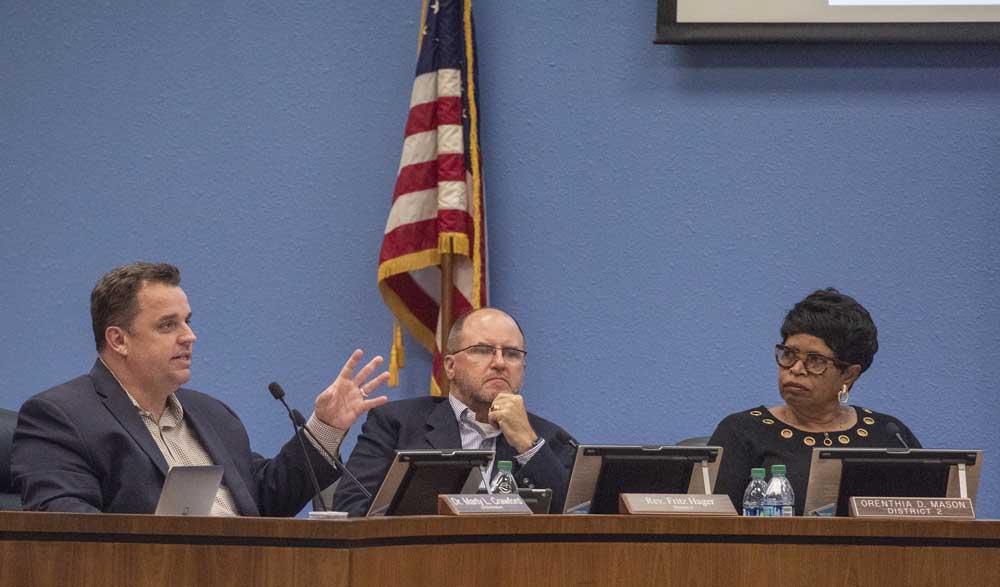Tyler ISD board approves replacing Head Start program with districtwide full day Pre-K
Published 9:34 pm Monday, June 17, 2019

- The Tyler ISD board of trustees meets on Monday June 17, 2019. Pictured from left: Superintendent Dr. Marty L. Crawford, Rev. Fritz Hager Jr. and Rev. Orenthia Mason. (Sarah A. Miller/Tyler Morning Telegraph)
The Tyler Independent School District will replace its Head Start program with districtwide full day Pre-K for the 2019-20 school year, after increased funding was approved by the state legislature.
The Tyler ISD Board of Trustees approved the move Monday night during its June board meeting.
Superintendent Marty Crawford said the primary reason for the move comes down to greater district control over its early education curriculum.
Crawford said Head Start, which is a federally funded program, has a set curriculum that has a lower standard than the district’s full day Pre-K programs and the district is unable to alter it.
“I need permission to go and fix the (Curriculum and Instruction) portion of early ed,” Crawford said.
Crawford said the district’s data shows that the full day Pre-K they offer at Andy Woods Elementary School has students entering kindergarten in better shape academically than the Head Start or the Half Day Pre-K programs.
The district has made significant improvements in accountability ratings over the past few years, but Crawford said having control of their entire early education curriculum is vital to seeing continued improvements.
By moving to full day Pre-K, they would be able to set the standard across the board.
Board members and members of the public expressed concern about the possible loss of “wraparound” products Head Start includes. During the public comment portion of the meeting, three members of the community asked the board to reconsider implementation of the plan or to guarantee students would not lose services that help low-income families.
Crawford said the expectation is for campus staff, such as nurses and counselors, to continue working with families on those services.
Assistant Superintendent of Schools Rawly Sanchez said nurses and counselors already coordinate with the early childhood department to ensure older siblings are receiving the same services.
“There are plenty of kids in Head Start now who have older brothers and sisters in our schools, so there already are some of those services being provided,” Sanchez said. “When we talk about educating the whole child, we’ve been doing it on our campuses already.“
Crawford expects to expand those services to pick up where some federally funded services will be lost, but the district does not know exactly what that will look like yet.
The discussion around the matter elicited some strong responses from the audience and board members.
District 2 Trustee Rev. Orenthia Mason and District 3 Trustee Freeman Sterling pushed for a clear commitment to maintaining the wraparound services.
“We will be the conduit for parents, we’ll structure ourselves to do that,” Crawford said. “Elementary counselors currently do this. That’s not going to go away with the implementation of Pre-K.”
Head Start currently serves 432 students. In Tyler ISD, the program serves students beginning at age 4, unless they have a disability, in which case they are eligible at 3 years old.
Assistant Superintendent for Curriculum and Instruction Dr. Christy Hanson said the special education department oversees the services for 3-year-olds and would continue to do so.
The district’s preliminary plan is to launch with two classrooms at most of the district’s 16 regular elementary school campuses, enabling them to serve more than 600 students in 2019-20, with room to grow.
The district alleviated overburdened campuses last year when it redrew its attendance zones, allowing them the room to add classrooms on each campus.
Crawford said that all of the district’s Head Start teachers are certified in early education and will be moved to either Pre-K or kindergarten classrooms. The district expects to move paraprofessional staff still under contract to other positions for which they are qualified.
“We want to find a happy medium,” Crawford told the board. “We’re also hoping to serve those families that aren’t qualifying for Head Start.”
About 75 percent of students would qualify for the free Pre-K but not all of those students would qualify for Head Start. Board members have been vocal about finding ways to serve families that fall into the gap between making too much to qualify and being able to actually afford tuition-based Pre-K.
According to a staffing plan presented to the board, of the more than two dozen Pre-K classrooms, only five will be tuition based.






